Introduction
Polyphonic digital/analog hybrid synths were popular in the mid 1980s, dethroning analog synths, due to the superior stability of digital oscillators, but keeping the warmth of analog filters. As sampling technology matured and memory prices dropped, sample based synths (a.k.a. romplers) replaced hybrid technology to become the dominant synth technology to this day. While hybrid synths offer a warm and unique sound (due to their analog filters), they couldn not compete with the realistic sounds found in romplers, since that was the era that all synths were judged by their "piano" emulation.
Korg released the Poly800, DW, and DSS families of hybrid synths to compete with the Roland Alpha Juno and JX families. The Poly800 family (Poly-800, EX-800, Poly-800II) was the entry level line, having a limited oscillator palette, shared filter, and no velocity or aftertouch sensitivity. The DW family (DW-6000, DW-8000, EX-8000) expands the oscillator palette with a more traditional architecture. Later versions (DW-8000 and EX-8000) added more waveforms (a trend that defines the current industry) and offered velocity and aftertouch sensitivity. The DSS-1 and DSM-1 cap Korg hybrid synth flexibility by adding 12 bit sampling, creating an open ended sound source. The DSS-1 and DSM-1 also have twice the resolution (64 settings vs. 32 in DW and Poly800 families) for most controls.
Oscillators
The Poly800 series starts with a square waveform (along with harmonics and noise), while the DW-6000 and DW-8000 (EX-8000) expand the waveform count to 8 and 16, respectively via 8 bit ROMs. The DSS-1 and DSM-1 top that by replacing the DW waveform ROM with 12 bit sample RAM, allowing the user to sample or harmonically synthesize waveforms (i.e. additive synthesis). Additionally, the DSS-1 has oscillator sync and allows the user to hand draw the waveform. The DSM-1 is the only synth in the group that does not have a noise source.
The Poly800 series enables each octave (16/8/4/2' with either flat or decreasing weight) for crude additive synthesis, while the DW series and DSS1 only enables a single octave (16/8/4') and the DSM-1 does not allow octave switching. The DSS-1 also has a more capable additive synthesis engine, featuring arbitrary levels for 128 sine wave harmonics. The Poly800 series can have 1 or 2 oscillators per voice (8 or 4 notes polyphony, respectively), while the DW series and DSS-1 are set at 2 oscillators per voice (8 note polyphony, except DW-6000, which has 6). The DSM-1 is set at 1 oscillator per voice (16 note polyphony), which explains the lack of oscillator sync (compared to the DSS-1). The DW and DSS families also have unison (i.e. monophonic detuned voice) modes.
Filter
Perhaps a more concise article title would be "2069 based synths", since all of these models share the Korg NJM2069 2/4 pole filter. However, the Poly-800 routes all voices through a single filter IC, while the other synths have a dedicated filter for each voice (conventional architecture). However, only the DSS-1 allows access to the 2 or 4 pole cutoff slopes (all others only use the 4 pole slope). Incidently, any of the models missing 2 pole access (i.e. Poly-800 series, DW series, DSM-1) could be modified to have the 2 or 4 pole filter selectable from an additional front panel switch (email service department for details). Curiously, the DSM-1 does not implement filter resonance.
Even though the Poly800, DW, and DSS families share the same filter chip, the differences in implementation in each synth does make a difference, as can be seen by these samples:
- Poly-800 noise 2 pole filter sweep
- Poly-800 noise 4 pole filter sweep
- Poly-800 noise 2 pole resonant filter sweep
- Poly-800 noise 4 pole resonant filter sweep
- Poly-800 square wave filter sweep (C1)
- Poly-800 square wave resonant filter sweep (C1)
- Poly-800 all square harmonics filter sweep (C1)
- Poly-800 all square harmonics resonant filter sweep (C1)
- DW-8000 self-oscillation resonant filter sweep
- DW-8000 saw wave filter sweep (C1)
- DW-8000 saw wave resonant filter sweep (C1)
- DW-8000 noise filter sweep
- DW-8000 noise resonant filter sweep
- DSS-1 saw wave filter sweep (C1)
- DSS-1 saw wave resonant filter sweep (C1)
- DSS-1 white noise filter sweep
- DSS-1 white noise resonant filter sweep
Performance Control
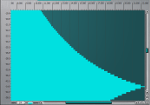
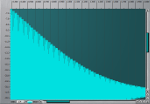
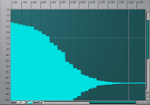
All models implement dedicated 6 element (ADBSSR) VCF and VCA EGs (envelope generator), but only the Poly800 series offers separate amplifier EGs for each oscillator, since the amplifiers are pre-filter vs. post-filter on the other models. Filter EGs also have a polarity switch. Due to low resolution (8 bit) DACs, DW and DSS-1 family show stair stepping in their envelopes (common with digitally controlled analog). The Poly800 family stepping is even worse. Luckily, the waveforms look a lot worse than they sound.
While no models offer EG to pitch routing, the DW/EX-8000 and DSS-1/DSM-1 have auto-bend. All models, except the Poly800 series and DSM-1, have portamento. Instead, the Poly-800 series models have a step sequencer, while the keyboard versions (Poly-800 and Poly-800II) also have chord memory. The DSM-1 introduces the multitimbral (4 voice) "Combination Mode", used by subsequent generations of Korg synths.
Keyboard filter cut-off tracking is provided by all families (Poly800 and DW: 4 choices; DSS-1/DSM-1: variable, 64 steps). Amplifier keyboard tracking is only available on the DSS-1 (decay) and DSM-1 (decay and release).

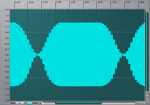
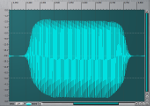
LFO is routed to oscillators and filter in all models, but the DSS-1 and DSM-1 have a dedicated LFO for each. The waveform is only selectable on the DSM-1 (triangle, square, sine) and DW/EX8000 (triangle, up saw, down saw square). All keyboard models offer a joystick to control LFO and bend. As with the EGs, the DW and DSS-1 families show stair stepping in their LFOs too. However, the Poly800 does not show stair stepping, due to analog LFO control.
While the Poly800 series and DW6000 do not have velocity or aftertouch sensitivity, the other models (DW/EX-8000, DSS-1, DSM-1) route aftertouch to LFO (DCO only for DW/EX-8000), VCF cut-off and VCA level. The DW/EX8000 routes velocity to the VCF cut-off and VCA level, while the DSS-1 and DSM-1 expand velocity sensitivity to sample switching, auto-bend, VCF and VCA rates (attack, decay, slope).
Effects
The Poly800, EX-800 and DW-6000 have stereo chorus. The DW/EX-8000 and Poly800II have a single stereo delay (with dedicated LFO), while the DSS-1 also has dual LFOs (summed) for dual DDLs and a two band shelving EQ. Instead of effects, the DSM-1 has 16 individual outputs.
Summary
While the DSS-1 is the clear winner for versatility and the DSM-1 the clear winner for polyphony, their weakness is their disk drive, which tend to wear out and are difficult to replace. However, an HxC floppy emulator can solve that issue. The Poly800 and DW families do beat the DSS family for accessibility, since the DSS family is significantly more complicated, due to the sampler section.